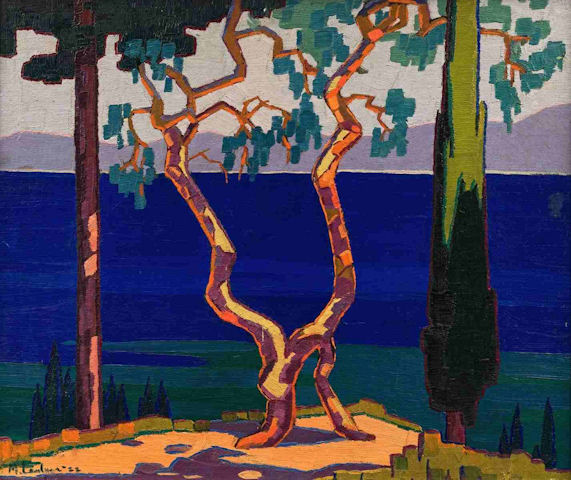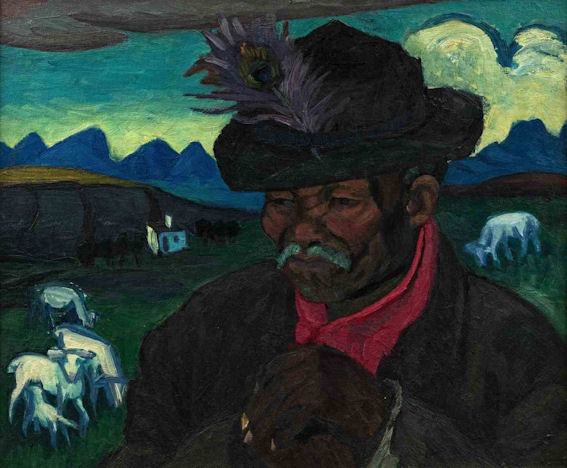Archived
Discovery of Double-sided Laubser Painting Delights at Strauss Spring Auction
7 Sep 2013
An extraordinary discovery was made when the owners of a beautiful Maggie Laubser painting decided to reframe it. To their surprise, they found an equally good painting on the back. According to Stephan Welz, South Africa’s top modern art expert and auctioneer, this remarkable double-sided painting, which is to be offered at Strauss & Co’s 21 October auction at the Vineyard Hotel in Newlands, also has an impeccable provenance and interesting history.


recto verso
It was purchased by Francois Petrus (Toon) van den Heever from an exhibition in Bloemfontein, and later given to his only daughter, Leonora, sometime before 1959. Following a brilliant legal career, that included practising at the Bar at Windhoek from 1921, Toon van den Heever was appointed Senior Law Advisor to the Union Government. In 1931 he was Secretary for Justice, Law Advisor for External Affairs and Government Attorney. Thereafter he was appointed to the Bench in Windhoek and transferred to Bloemfontein in the Appeal Court.
He was instrumental in according Afrikaans equal status with English and was the outstanding new poet of the 1920s, whose anti-conformist verse foreshadowed the great upsurge of ‘new’ Afrikaans poetry in the 1930s. Drawing on conflicts in the transition from a rural to an urban society, his poetry implied a natural bond between the farmer and the soil. Included in his circle of close friends were Eugène Marais and JH Pierneef, who produced several portraits of Toon.
Judge Leonora van den Heever is the first and for twenty years was the only woman to have been appointed a Judge of the Supreme Court in South Africa. She was also the first female judge appointed to the Appeal Court in Bloemfontein.
The landscape painting is undoubtedly a key painting in the development of South African modernism, says Emma Bedford, Senior Art Specialist at Strauss & Co. Beneath a shimmering lilac sky, the dazzling ultramarine sea is bracketed by an olive green cypress and the gnarled orange and mauve trunk and teal leaves of what is probably an olive tree. These motifs are typical of her Italian paintings produced while living and painting near Lake Garda in 1920 and on her return to Italy in 1921. While her brilliant treatment of the subject evinces the vividness of observed reality, Laubser may well have worked from her sketches to paint this on her return to South Africa.
The shepherd, who worked on the family farm Oortmanspoort, was a favourite subject. With his hands folded together under his chin, as if leaning on a stick, he is shown surrounded by sheep in the cool fields of an early morning. The brightening sky on either side of his hat, with jaunty feather proudly inserted into the band, and his crimson scarf reflected in the warm tones of his skin, highlight the artist’s empathetic portrayal of the local farm workers.
Echoing Toon van der Heever’s poetic explorations of the ties binding farmers to the soil, the portrait epitomises the pastoral idylls that have made Laubser such a sought-after artist in South Africa. By contrast, the landscape retains all the vigour of her German Expressionism mentors while hinting at the life of languor evoked in Henri Matisse’s Riviera vacation paintings.
These two paintings, the landscape inspired by her studies and travels in Europe and the shepherd evoking her local agricultural roots, encapsulate the multifaceted nature of Maggie Laubser who, despite her humble origins, made one of the most important contributions towards redefining South African art.
In describing the shift that occurred in the artist’s style during her sojourn in Italy between October 1920 and August 1921, art historian, Liz Delmont, says that while Maggie Laubser continued to paint directly from nature:
there is a definite shift from the descriptive picturesque interpretation practised up until this time, to a more abstracted decorative style,
in which there is a simplification of form, reduction of detail and intensification of hues …
Laubser’s development while in Belgium, but more particularly in Italy, towards a stronger and more high-keyed palette should be understood
within the context of her ideas and beliefs. For her, very clear and recognizable forms were to be found in nature … This mode of perceiving
finds its parallel in her painting for, by using stronger, purer colours and greater contrasts of hues in large defined areas, there is an
intensification and clarity of shape. By her use of colour, therefore, she expressed her consciousness of structure rather than superficial
appearance in nature thus creating a work of clarity and order, paralleling the “perfection of creation”.
Maggie Laubser
Lake Scene with Trees and Mountains, recto; Portrait of an Old Man with Hat; Landscape with Trees and Sheep in the Background, verso
signed and dated ‘22
oil on board
49 x 58cm
R500 000 – 700 000
Media Liaison:
Bina Genovese, Executive Director +27 (0) 21 683 6560 / +27 (0) 78 044 818
Important South African Art & Furniture, Decorative Arts & Jewellery
including The Dr Johan Bolt Cape Collection
Monday 21 October 2013
Session 1 at 10am
Session 2 at 1.30 pm
Session 3 at 3.30pm
Session 4 at 5.30pm
Session 5 at 8pm
VENUE
The Vineyard Hotel, Newlands
Colinton Road (off Protea Road)
GPS Co-ordinates: S 33° 58’ 44.6” E 18° 27’ 31.1”
PREVIEW
Friday 18 to Sunday 20 October 10am to 5pm
WALKABOUTS
Conducted by Stephan Welz and Emma Bedford
Saturday 19 and Sunday 20 October at 11am
ENQUIRIES
+27 (0) 21 683 6560
Mobile +27 (0) 78 044 8185
Fax: +27 (0) 21 683 6085
ILLUSTRATED CATALOGUE R150.00
2013 Press Releases
November
October
- 14 Oct 2013 Strauss Online: Time-limited auction sales exclusively online
- 20 Oct 2013 Pocket Money to Millions & students keen eye for art admirably rewarded
- 30 Oct 2013 As Large as Life The Ceramics of Irma Stern
- 30 Oct 2013 Seminal works from Jane Alexander's masters show destined for auction
- 30 Oct 2013 Staging a moment in art - William Kentridge and Opera
- 30 Oct 2013 Through The Eyes Of An Artist - Romantic Accounts Of Africa
September
- 7 Sep 2013 Discovery of Double-sided Laubser Painting Delights at Strauss Spring Auction
- 7 Sep 2013 Hodgins for the brave
- 7 Sep 2013 Hot Stuff from Goodman
- 7 Sep 2013 Humanist's Vision of Early Cape Town
- 7 Sep 2013 Kentridge's Queen of the Night
- 7 Sep 2013 Kruger on the Station
- 7 Sep 2013 Pierneef on a Grand Scale
- 7 Sep 2013 Preller's Exotic Explorations
- 7 Sep 2013 Stern Scintillates at Strauss & Co's October Auction
- 7 Sep 2013 Stern's Island Reveries
- 7 Sep 2013 The Pleasures of Food, Friends and Art
- 7 Sep 2013 WWF Art Auction Poised to Raise Record Funds
- 18 Sep 2013 Millions raised at WWF Art Auction
May
- 10 May 2013 Vladimir Tretchikoff's unique rendition of Prima Ballerina Assoluta, Alicia Markova
- 10 May 2013 You only live twice.....
- 15 May 2013 Strauss & Co to sell one of the world's most reproduced paintings
- 15 May 2013 Tretchi fever heats up
- 20 May 2013 R1 818 880 for Last Supper
- 24 May 2013 Private donation of iconic Chris Levin designs to boost Iziko Collection
April
- 24 Apr 2013 Iconic South African artworks spanning 160 years set to go under the hammer in May
- 29 Apr 2013 Strauss & Co goes Vintage with South African Haute Couture Legend, Chris Levin
February
January
- 1 Jan 2013 "Dis 'n genot van die hart" se Laubser
- 1 Jan 2013 Early Naude' Captures Charms of a Bygone Era at the Cape
- 1 Jan 2013 Gem of a Painting evokes Malay Quarter
- 1 Jan 2013 Large Battiss Combines Sensuality and Virtuosity
- 1 Jan 2013 One of Stern's Most Compelling Portraits
- 1 Jan 2013 Rare Siopis at Auction
- 1 Jan 2013 Van Wouw Skill Shines in Early Italian cast
- 3 Jan 2013 Cape Furniture From The Collection Of Dr Bothma Buitendag, For Sale At Strauss & Co
- 3 Jan 2013 Impact of Modernism Demonstrated in Seminal Painting
- 3 Jan 2013 Important Cape Silver presentation covered cup, John Townsend, circa 1830
- 10 Jan 2013 Contemporary Jewellery by Design Maestro Erich Frey For Sale At Strauss & Co
- 14 Jan 2013 Chairman's Report 2012
